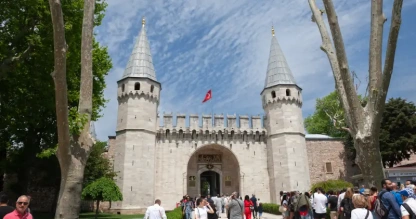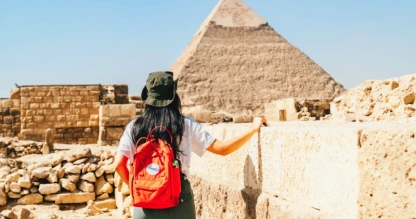
Exploring Istanbul’s Grand Bazaar
The Istanbul Grand Bazaar ranks among the world's largest and oldest covered markets. Its vast expanse includes 61 covered streets and more than 4,000 shops. Each day, 250,000 to 400,000 visitors walk through its winding pathways.
The Grand Bazaar stands as one of the earliest shopping malls ever built. Shoppers will find a rich source of options here. Traditional ceramics, stunning jewelry, intricate carpets, and aromatic spices fill the stalls.
This detailed guide delves into the rich history and vibrant atmosphere that shapes this centuries-old trading hub. It helps travelers guide through its bustling corridors to uncover hidden gems while highlighting its cultural significance.
First Impressions: Entering the Grand Bazaar
Visitors who pass through any of the 22 gates of the Istanbul Grand Bazaar step into a different universe where time stands still. The contrast between Istanbul's bustling streets and this historic marketplace hits you right away.
The maze of streets and domes
The Grand Bazaar's maze-like design engages first-time visitors on their Turkey tour. This magnificent covered maze spans 45,000 square meters, which equals about five Manhattan city blocks. The structure features 61 covered streets that form a rectangular pattern with a central square.
The bazaar's architecture speaks through its covered walkways and towering domes. Two covered bazaars are the foundations of this commercial maze. The inner covered bazaar (Cevahir Bedesten), believed to be a Byzantine building, stretches 48×36 meters with brick domes that rest on 8 solid columns. The Sandal Bedesten has 20 brick domes supported by 12 massive pillars known as "elephant feet" and measures 40×32 meters.
The vaulted ceilings and hand-painted domes showcase traditional craftsmanship, while red-tiled roofs protect each shop. Lead sheets once covered these roofs, but clay tiles from Marseille and later regular tiles replaced them.
Sounds, scents, and colors of the market
The Grand Bazaar fills visitors' senses with countless stimuli that define Istanbul. Traders' voices echo up to the hand-painted, vaulted ceilings as they call out to potential buyers.
The market creates an array of sensations. Bright textiles hang next to shining copper goods, while exotic spices mix with the aroma of fresh Turkish coffee. Scents of saffron, sumac, and cumin drift through the corridors, creating a fragrant map of the marketplace.

A Walk Through History
The magnificent Istanbul Grand Bazaar started in the winter of 1455/56. Sultan Mehmed the Conqueror ordered its construction right after the Ottoman conquest of Constantinople. The ambitious project aimed to boost economic growth in the newly conquered city. Construction began with the Cevahir Bedesten, a structure that served as a trading hub for textiles and jewels.
From 15th-century roots to modern marvel
Workers completed the Cevahir Bedesten (also known as "Bedesten of Gems") in the winter of 1460/61. The core structure measured 48×36 meters with brick domes that sat on 8 pedestals.
The Hagia Sophia Mosque's waqf received this building as an endowment. A second significant addition came between 1545-1550 with the Sandal Bedesten. This rectangular building covered 2,435 square meters and had 20 lead-plated domes.
The Grand Bazaar grew bigger as workers covered nearby streets and merged neighboring hans (inns) into the complex. Each street in the bazaar belonged to a specific profession. These old craft traditions live on through street names today, even though many of these trades no longer exist.
How the bazaar evolved over centuries
The Grand Bazaar, finalized in the 17th century, became a key hub of Mediterranean trade due to its location between Asia and Europe. Praised by travelers for its variety and quality, it later faced disasters, including the 1894 earthquake and economic decline in the 19th century. Restored in 1980, it remains one of Istanbul’s most iconic landmarks today.

Shopping at the Grand Bazaar: What to Expect
The Istanbul Grand Bazaar stands out as one of the world's most remarkable shopping destinations.
What to buy at the Grand Bazaar
Turkish craftsmanship shines throughout the bazaar's stalls. Handmade carpets and kilims top most visitors' shopping lists, with small pieces and larger rugs reaching several thousand dollars. Beautiful Ottoman-inspired gold and silver jewelry ranges from $20 to $600, depending on the materials used. Shoppers can also find:
- Leather goods: High-quality jackets and handbags
- Hand-painted ceramics and pottery: Beautiful tiles, plates, and bowls
- Turkish lanterns: Stunning glass or metal pieces
- Spices, teas, and Turkish delights: Perfect tastes of Turkey to take home
Navigating the shops and bargaining tips
Bargaining makes up an essential part of shopping at the Grand Bazaar. Shopping between 11:00 and 13:00 often leads to better deals since merchants want to make their first sales of the day.
A friendly and respectful approach works best during negotiations. Shopkeepers often serve tea while discussing their products. Taking time to enjoy this hospitality lets you learn more about what you're buying while building a connection with the seller.
Popular streets and specialty areas
Different areas of the Grand Bazaar focus on specific types of goods. Carpet hunters head to Halıcılar Street, while jewelry enthusiasts browse Kuyumcular Caddesi. The Inner Bedesten houses precious antiques and valuable items. Çadırcılar Street offers a more local experience where Istanbul residents shop for everyday items.

Cultural Insights and Hidden Corners
The Istanbul Grand Bazaar has served as more than just a marketplace - it became a thriving social and cultural center throughout its history.
The role of guilds and artisan traditions
The bazaar's operations followed strict guild regulations during Ottoman times. These guilds carefully controlled their membership. New members could only join by inheriting a deceased member's position or buying out a retiring member's spot.
Religious and social customs in the bazaar
Religious organizations known as fütüvvet tariks played the most important roles alongside commercial guilds initially. Their influence decreased as Greek, Armenian, and Jewish merchants became more prominent.
Ottoman law required specific shoe colors based on faith - Muslims wore yellow, Greek Orthodox chose blue, Jews had black, and Armenians walked in red shoes. The shoe market displayed this colorful variety proudly.
Famous cafés, fountains, and architectural gems
Visitors can now find beautiful hidden hans (courtyards) like the 18th-century Zincirli Han. This former caravanserai now houses traditional craftsmen's workshops. The bazaar's artistic heritage shines through its ornately painted ceilings and stunning stained-glass windows. Çinili Cafe serves delicious Turkish coffee and rose lemonade surrounded by sparkling antiques and textiles.
Discover the best of Turkey on our Turkey tours and Middle East trips!

FAQS
1. What is the Grand Bazaar in Istanbul famous for?
The Grand Bazaar is one of the largest and oldest covered markets in the world, famous for its maze of shops selling jewelry, carpets, spices, textiles, ceramics, and traditional Turkish goods.
2. How old is the Grand Bazaar in Istanbul?
The bazaar dates back to the 15th century, built shortly after the Ottoman conquest of Constantinople in 1453, making it over 550 years old.
3. How many shops are inside the Grand Bazaar?
The Grand Bazaar has more than 4,000 shops spread across 60+ streets, attracting hundreds of thousands of visitors daily.
4. What can you buy at the Grand Bazaar?
Visitors can find Turkish carpets, kilims, lamps, leather goods, spices, antiques, gold jewelry, souvenirs, and artisanal crafts. Bargaining is common and expected.
5. When is the best time to visit the Grand Bazaar?
The best time is weekday mornings, when it’s less crowded and shopkeepers are more eager to make their first sale, often considered lucky.













